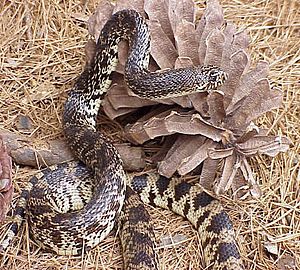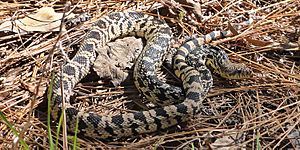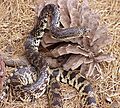Louisiana pinesnake facts for kids
Quick facts for kids Louisiana pinesnake |
|
|---|---|
 |
|
| Conservation status | |
| Scientific classification | |
| Genus: |
Pituophis
|
| Species: |
ruthveni
|
| Synonyms | |
|
|
The Louisiana pine snake (Pituophis ruthveni) is a large snake. It is not venomous, meaning it does not have poison. This powerful snake is special because it lays very large eggs. It also has only a few eggs at a time.
This snake lives naturally in west-central Louisiana and East Texas. It depends a lot on Baird's pocket gophers. These gophers dig burrows, which the snakes use as homes. The gophers are also a main food source for the snakes.
The Louisiana pine snake is very hard to find in the wild. It is one of the rarest snakes in North America. Its numbers have dropped because it has few babies. Also, its home, the longleaf pine forests in the Gulf Coastal Plain of the Southern United States, has been largely destroyed. People are now working to help this special snake recover.
Contents
- Snake Science: Naming the Louisiana Pine Snake
- What Does the Louisiana Pine Snake Look Like?
- Growth and Life Cycle
- How Louisiana Pine Snakes Behave
- Where Louisiana Pine Snakes Live
- Where Are They Found and How Are They Doing?
- Why Are They in Danger?
- Helping the Louisiana Pine Snake Recover
- Images for kids
Snake Science: Naming the Louisiana Pine Snake
This snake was first described by a scientist named Olive Griffith Stull in 1929. She first thought it was a type of P. melanoleucus snake. Later, in 1940, Stull decided it was its own unique species.
The snake's scientific name, Pituophis ruthveni, honors Alexander Grant Ruthven. He was a famous scientist who studied reptiles and amphibians. He worked at the University of Michigan Museum of Zoology.
What Does the Louisiana Pine Snake Look Like?
The Louisiana pine snake has a buff or yellowish-brown color on its back. It has dark brown blotches and spots all over its body. These markings look very similar from head to tail.
However, the patterns change a bit. Near the neck, the dark spots are closer together. Towards the middle and tail, the dark markings become clearer. The snake's head is pointed and might have a few small dots. Its belly is usually blotched with brown.
A special feature of this snake is its very large rostral scale. This is the scale right at the tip of its nose.
Growth and Life Cycle
Louisiana pine snakes grow very quickly. They can reach about 2 to 3 feet (60 to 90 cm) long in their first year. By two years old, they can be 3 to 4 feet (90 to 120 cm) long. The longest one ever found was about 5.8 feet (177 cm) long!
These snakes can start having babies when they are at least 3 years old. They need to be about 4 feet (120 cm) long. Louisiana pine snakes lay eggs. The eggs develop inside the mother for about 21 days. Then, after the eggs are laid, they hatch in about 60 days.
This snake has a very low number of babies. It has the smallest clutch size (3 to 5 eggs) of any snake in North America. But its eggs are the largest! They are usually about 5 inches (13 cm) long and 2 inches (5 cm) wide. The baby snakes are also very big when they hatch. They are usually 18 to 22 inches (46 to 56 cm) long and weigh up to 0.8 ounces (23 grams). Being born large might help the young snakes find food sooner.
How Louisiana Pine Snakes Behave
Studies show that these snakes spend most of their time, at least 60%, underground. They usually move only short distances, about 10 to 20 feet (3 to 6 meters), when they are underground. They are most active in the late morning and afternoon. They are least active at night and early morning.
When above ground, they often go back underground during the day. They might do this to find food, cool down, or hide from predators. When it's cold, they hibernate (sleep for the winter) in pocket gopher burrows.
The snakes are most active from March to May and in the fall, especially November. They are least active during winter (December to February) and summer (especially August). They almost always use Baird's pocket gopher (Geomys breviceps) burrows as their hiding spots. Pocket gophers are also their main food. But they also eat other rodents, rabbits, amphibians, and ground-nesting birds and their eggs.
Their home range can be from 12 acres (5 hectares) for young snakes to 195 acres (79 hectares) for adults. On average, it's about 69 acres (28 hectares). Adult males tend to have larger home ranges than females. Snakes usually move less than 33 feet (10 meters) daily. But when they move to a new gopher burrow system, they can travel much farther.
Where Louisiana Pine Snakes Live
The Louisiana pine snake prefers sandy, well-drained soils. It likes open pine forests, especially longleaf pine savannas. These areas have few tall shrubs but lots of grass and other plants on the ground.
Their activity is mostly on low, wide ridges with sandy soil. Baird's pocket gophers are super important for them. The gophers dig the burrows that the snakes use for shelter and food. Most of the time, radio-tagged snakes are found underground in gopher burrows. If a snake is disturbed above ground, it quickly goes into a nearby burrow.
For gophers to be plentiful, there needs to be a lot of plants on the ground and loose, sandy soil. A lot of ground plants means that sunlight can reach the forest floor. So, gophers are more common where there are fewer trees and an open tree canopy. This allows more sunlight, more understory growth, and better food for the gophers.
Where Are They Found and How Are They Doing?
Louisiana pine snakes used to live in at least 9 areas in Louisiana and 14 in East Texas. This was in the longleaf pine ecosystem west of the Mississippi River. Now, they are found in only four Louisiana areas and at most five Texas areas.
In Texas, they are only confirmed in parts of the Sabine National Forest and nearby private land. They are also in parts of the Angelina National Forest and nearby timberland. In Louisiana, most records are from Bienville Parish. Another group lives on federal lands in Vernon Parish. A third group might be near the border of Vernon, Sabine, and Natchitoches Parishes.
The number of Louisiana pine snakes has dropped a lot in the last 50 to 80 years. Scientists looked at old snake habitats. They found that only 34% of them could still support a healthy snake population. In some of the best remaining habitats, the snake hasn't been seen in over ten years. This means it might be gone from those areas or extremely rare. It is now known as one of the rarest snakes in North America. It is also one of the rarest animals with backbones in the United States.
Why Are They in Danger?
Loss of Homes
Many things have caused the loss of pine snake homes. These include building cities, turning land into farms, building roads, and mining. People also catching snakes for pets might have hurt populations.
But the biggest problem is the loss of their natural longleaf and shortleaf pine forests. Most of the trees in the South were cut down between 1870 and 1920. By 1935, only 3% of the original longleaf pine forests in Louisiana and Texas were left untouched. Today, even less remains.
Most of these old forests have been replaced with tree farms. These farms grow fast-growing loblolly and slash pine trees. These tree farms are very dense, with trees growing close together. They are harvested quickly, usually in less than 40 years. These forests don't have many plants on the ground. This makes them unsuitable for pocket gophers, and thus for pine snakes.
Stopping Wildfires
Any pine snake habitat left is often in small, separate areas. It is also often damaged because there are no regular wildfires. Stopping natural fires might be the biggest threat to the Louisiana pine snake recently. It reduces both the amount and quality of habitat for the snakes.
The longleaf pine savanna forest needs frequent, low-intensity fires to stay healthy. These fires keep the forest open. They allow sunlight to reach the ground. This helps native grasses and other plants grow. These park-like forests are perfect homes for pocket gophers, and so for pine snakes.
Without regular fires, the forest gets too dense. A thick layer of shrubs grows, which blocks sunlight. This kills the plants on the ground. Since pocket gophers need these ground plants, their numbers drop. No pine snakes have been found in areas badly damaged by fire suppression.
Pine snakes are actually good at surviving fires. When flames get close, snakes above ground quickly move into pocket gopher burrows. Studies showed that nine pine snakes in areas with controlled burns all survived without harm.
Car Accidents
Louisiana pine snakes are also hurt by cars and off-road vehicles. Researchers have seen three snakes killed by vehicles. Roads with a lot of traffic can reduce large snake populations by 50-75%. This can happen up to 2800 feet (850 meters) from the road.
There are known problems with vehicles and pine snakes in parts of the Angelina National Forest. Off-road vehicles have damaged some important plant communities there. In Sabine National Forest, vehicle problems happen in other specific areas.
Helping the Louisiana Pine Snake Recover
Snakes that have few babies, like the Louisiana pine snake, cannot recover quickly when their numbers drop. The survival of the Louisiana pine snake depends on the Baird's pocket gopher. The gopher's numbers depend on the plants and sandy soil of the longleaf pine forests.
In March 2004, eight state and federal groups signed an important agreement. This agreement helps protect the Louisiana pine snake on federal lands in Texas and Louisiana. These groups include Fort Polk Military Installation, Kisatchie National Forest, and state wildlife departments.
This agreement helps the groups work together. They can share information on what works best to manage the land. They also coordinate research efforts. Using fire is a key part of helping the snake recover.
The plan is to bring back and protect the remaining longleaf pine forests. Frequent, low-intensity fires are needed to keep these forests open. Many plants in these forests actually need to burn to grow or reproduce. Longleaf pine forests are very special places. They are some of the most diverse ecosystems outside of tropical areas. More than 30 plant and animal species in these forests are endangered or a concern.
The American Zoo and Aquarium Association has a Species Survival Plan for the Louisiana pine snake. It is based at the Memphis Zoo. This plan helps manage the captive snake population in zoos. There are fewer than 100 of these snakes in zoos. The plan makes sure they are cared for wisely for a long time.
Images for kids




